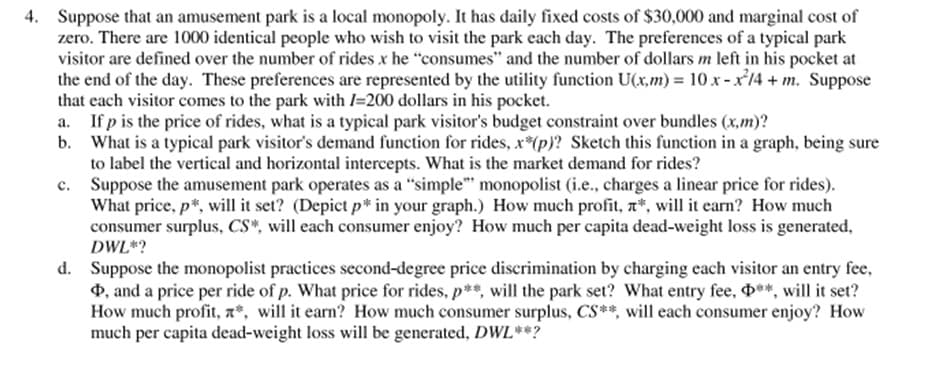4. Suppose that an amusement park is a local monopoly. It has daily fixed costs of $30,000 and marginal cost of zero. There are 1000 identical people who wish to visit the park each day. The preferences of a typical park visitor are defined over the number of rides x he "consumes" and the number of dollars m left in his pocket at the end of the day. These preferences are represented by the utility function U(x,m) = 10 x-x14 + m. Suppose that each visitor comes to the park with I=200 dollars in his pocket. If p is the price of rides, what is a typical park visitor's budget constraint over bundles (x,m)? b. What is a typical park visitor's demand function for rides, r*(p)? Sketch this function in a graph, being sur to label the vertical and horizontal intercepts. What is the market demand for rides? c. Suppose the amusement park operates as a "simple" monopolist (i.e., charges a linear price for rides). What price, p*, will it set? (Depict p* in your graph.) How much profit, n*, will it earn? How much consumer surplus, CS*, will each consumer enjoy? How much per capita dead-weight loss is generated, DWL*? d. Suppose the monopolist practices second-degree price discrimination by charging each visitor an entry fee ill it
4. Suppose that an amusement park is a local monopoly. It has daily fixed costs of $30,000 and marginal cost of zero. There are 1000 identical people who wish to visit the park each day. The preferences of a typical park visitor are defined over the number of rides x he "consumes" and the number of dollars m left in his pocket at the end of the day. These preferences are represented by the utility function U(x,m) = 10 x-x14 + m. Suppose that each visitor comes to the park with I=200 dollars in his pocket. If p is the price of rides, what is a typical park visitor's budget constraint over bundles (x,m)? b. What is a typical park visitor's demand function for rides, r*(p)? Sketch this function in a graph, being sur to label the vertical and horizontal intercepts. What is the market demand for rides? c. Suppose the amusement park operates as a "simple" monopolist (i.e., charges a linear price for rides). What price, p*, will it set? (Depict p* in your graph.) How much profit, n*, will it earn? How much consumer surplus, CS*, will each consumer enjoy? How much per capita dead-weight loss is generated, DWL*? d. Suppose the monopolist practices second-degree price discrimination by charging each visitor an entry fee ill it
Principles of Economics, 7th Edition (MindTap Course List)
7th Edition
ISBN:9781285165875
Author:N. Gregory Mankiw
Publisher:N. Gregory Mankiw
Chapter15: Monopoly
Section: Chapter Questions
Problem 7PA
Related questions
Question
100%

Transcribed Image Text:4. Suppose that an amusement park is a local monopoly. It has daily fixed costs of $30,000 and marginal cost of
zero. There are 1000 identical people who wish to visit the park each day. The preferences of a typical park
visitor are defined over the number of rides x he "consumes" and the number of dollars m left in his pocket at
the end of the day. These preferences are represented by the utility function U(x,m) = 10 x -x14 + m. Suppose
that each visitor comes to the park with l=200 dollars in his pocket.
a. If p is the price of rides, what is a typical park visitor's budget constraint over bundles (x,m)?
b. What is a typical park visitor's demand function for rides, x*(p)? Sketch this function in a graph, being sure
to label the vertical and horizontal intercepts. What is the market demand for rides?
c. Suppose the amusement park operates as a "simple" monopolist (i.e., charges a linear price for rides).
What price, p*, will it set? (Depict p* in your graph.) How much profit, n*, will it earn? How much
consumer surplus, CS*, will each consumer enjoy? How much per capita dead-weight loss is generated,
DWL*?
d. Suppose the monopolist practices second-degree price discrimination by charging each visitor an entry fee,
4, and a price per ride of p. What price for rides, p**, will the park set? What entry fee, **, will it set?
How much profit, a*, will it earn? How much consumer surplus, CS**, will each consumer enjoy? How
much per capita dead-weight loss will be generated, DWL**?
Expert Solution
This question has been solved!
Explore an expertly crafted, step-by-step solution for a thorough understanding of key concepts.
This is a popular solution!
Trending now
This is a popular solution!
Step by step
Solved in 2 steps with 1 images

Knowledge Booster
Learn more about
Need a deep-dive on the concept behind this application? Look no further. Learn more about this topic, economics and related others by exploring similar questions and additional content below.Recommended textbooks for you

Principles of Economics, 7th Edition (MindTap Cou…
Economics
ISBN:
9781285165875
Author:
N. Gregory Mankiw
Publisher:
Cengage Learning

Principles of Economics (MindTap Course List)
Economics
ISBN:
9781305585126
Author:
N. Gregory Mankiw
Publisher:
Cengage Learning

Principles of Microeconomics (MindTap Course List)
Economics
ISBN:
9781305971493
Author:
N. Gregory Mankiw
Publisher:
Cengage Learning

Principles of Economics, 7th Edition (MindTap Cou…
Economics
ISBN:
9781285165875
Author:
N. Gregory Mankiw
Publisher:
Cengage Learning

Principles of Economics (MindTap Course List)
Economics
ISBN:
9781305585126
Author:
N. Gregory Mankiw
Publisher:
Cengage Learning

Principles of Microeconomics (MindTap Course List)
Economics
ISBN:
9781305971493
Author:
N. Gregory Mankiw
Publisher:
Cengage Learning

Essentials of Economics (MindTap Course List)
Economics
ISBN:
9781337091992
Author:
N. Gregory Mankiw
Publisher:
Cengage Learning

Principles of Microeconomics
Economics
ISBN:
9781305156050
Author:
N. Gregory Mankiw
Publisher:
Cengage Learning

Principles of Economics 2e
Economics
ISBN:
9781947172364
Author:
Steven A. Greenlaw; David Shapiro
Publisher:
OpenStax